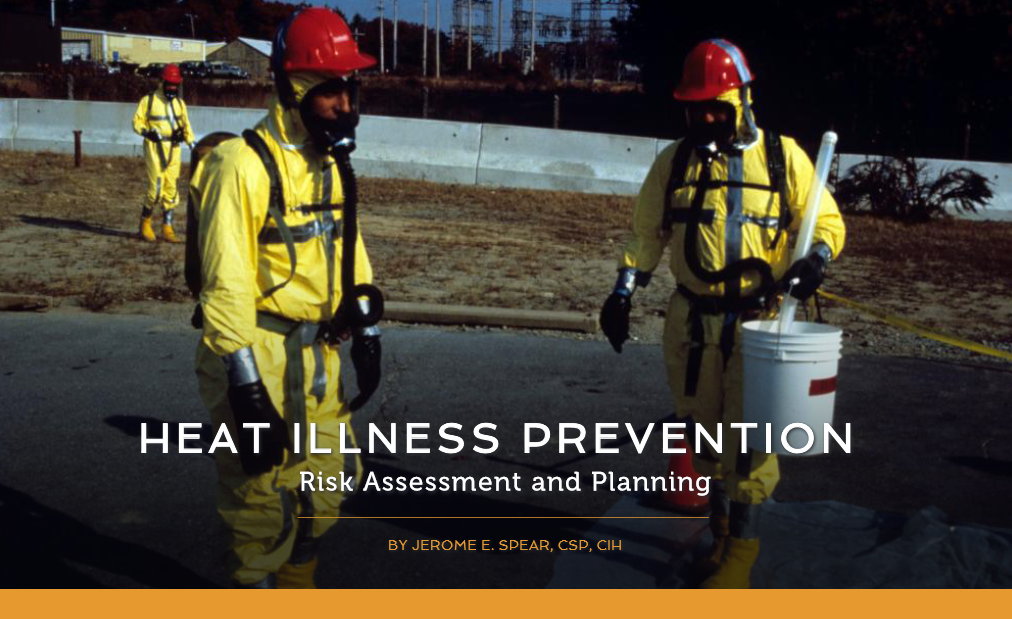
Heat Illness Prevention: Risk Assessment and Planning

The Statistical Abstracts of the United States, 105th edition, estimates that 5 to 10 million workers are exposed to heat illness annually. Heat illnesses (such as heat stroke, heat exhaustion, and heat cramps) are caused by hot environments and are preventable occupational health hazards.
Heat illness results when the body is out of heat balance. Heat balance means that the heat the body produces equals the heat it loses. When the body is out of heat balance, it produces and retains more heat than it loses causing heat illness. Heat illnesses range from heat rash and heat cramps to heat exhaustion and heat stroke. Heat stroke can result in death and requires immediate medical attention.
The steps to protect employees from heat illness are the same type of steps to follow to address other hazards in the workplace. These are
1) develop an illness prevention plan for outdoor work based on both the environmental and personal risk factors,
2)train your workers how to recognize and prevent heat-related illness,
3) track and monitor daily the environmental risk factors (such as the heat index) and communicate the required precautions to workers, and
4) implement your plan and revise the plan, as needed, throughout the summer.
THE HEAT INDEX
The major way the body looses heat is through sweating. High relative humidity reduces the body’s heat loss through sweating. Therefore, during periods of high relative humidity, there is a greater risk of developing heat illness. An indication of how relative humidity affects the risk of developing heat illness is called a heat index value, which was developed by the National Oceanic and Atmospheric Administration (NOAA). Heat index values, sometimes referred to as “apparent temperatures,” are given in degrees Fahrenheit (ºF) and measure how hot it really feels when relative humidity and air temperatures are both considered (see http://www.weather.gov/om/heat/index.shtml#heatindex). The NOAA’s heat alert procedures are based mainly on Heat Index Values.
To find the heat index temperature, look at the heat index chart below. As an example, if the air temperature is 96 °F and the relative humidity is 65%, the heat index – how hot it feels – is 121 °F. The heat index chart shaded zone above 105 °F shows a level that may cause increasingly severe heat disorders with continued exposure or physical activity. The Weather Service will initiate alert procedures when the Heat Index is expected to exceed 105°-110°F (depending on local climate) for at least two consecutive days.
HEAT INDEX RISK LEVELS
The heat index can be used to help determine the risk of heat-related illness for outdoor workers, what actions are needed to protect workers, and when those actions are triggered. Depending on the heat index value, the risk for heat-related illness can range from lower to very high to extreme. As the heat index value goes up, more preventive measures are needed to protect workers. Heat index values are divided into four bands associated with four risk levels (see Table 1). These bands differ from those appearing in the NOAA heat index chart, which was developed for the public. The NOAA bands have been modified for use at worksites:
Important consideration:
NOAA devised the heat index values for shaded conditions and light winds. Full sunshine can increase heat index values by up to 15° Fahrenheit. Strenuous work and the use of heavy or specialized protective clothing also have an additive effect. As a result, the risk at a specific heat index could be higher than that listed in the table above if the work is in direct sunlight without a light breeze, or if work involves strenuous tasks or the use of heavy or specialized protective clothing. Extra measures, including implementing precautions at the next risk level, are necessary under
these circumstances.

PLANNING
Use the protective measures to take at each risk level as the basis of your planning. The plan should address the elements
listed in Table 2, at a minimum:

Adapted from OSHA website, Preventing Heat Illness in Outdoor Workers

Implement your plan when the heat index is at or above 80° Fahrenheit. Adjust the risk level based on site conditions (e.g., direct sunlight vs. shaded, with breeze), work load, and type of protective clothing.
Use checklists to prepare for hot weather and to make sure that all appropriate precautions are in place. Download the Planning Ahead Checklist and Daily Planning for Working in High Heat from OSHA’s official site.

EFFECTIVE COMMUNICATIONS
When working in warm or hot weather, an effective communication system is a critical part of your program to be successful in preventing heat illness. As temperatures increase and other environmental factors change throughout the workday, employees’ physical and/or mental state can rapidly change into a serious medical condition. Therefore, it is important that you stay alert to the weather. The goal is to make appropriate adjustments in work practices and activities before problems arise or become serious or summon help if it is needed. In order to do this, an effective communication system must be implemented to contact employees and supervisors in the workplace.
Some “tools” for effective real time communication in remote locations include the use of cell phones, walkie-talkies, two way radios, satellite phones, and other devices. Employees and supervisors need to be fully trained on how to use your communication system to prevent heat illness.
During warm or hot weather and high heat, it is necessary for supervisors and employees to be attentive to each other and communicate on a frequent basis about how they are feeling. It is important to encourage employees not to discount any discomfort or symptoms they are experiencing and to report these problems immediately to their supervisor and coworkers. Employees and supervisors should be fully trained on the prevention of heat illness.
Using an effective communication system allows employees to report to supervisors, co-workers or other designated persons how they are feeling on a real time basis. Some practical suggestions include:
- Designating a person(s) to closely monitor and frequently report on employees’ physical and mental condition.
- Using a “buddy system” so that supervisors or a designated person(s) and coworkers can watch each other closely for discomfort or symptoms of heat illness. Are employees looking and acting normal throughout the work shift?
- Accounting for the whereabouts of your crew at appropriate intervals throughout the work shift and at the end of the workshift (e.g., keep a log of employees on your work crews including their names, supervisors, work locations, and hours worked ona given day, etc.).
- Ensuring that employees who work alone have a special system to monitor them closely by having them “check-in” periodically and account for their whereabouts (e.g., procedures to follow and a reliable means of communication for employees and supervisors to use).
- Holding short, frequent meetings (e.g., before and during work).
- Having frequent “check-ins” by the “designated person(s)” and supervisors.
STAY ALERT TO THE WEATHER
As temperatures increase and other environmental factors change throughout the workday, employees’ physical and mental state can also rapidly change into a serious medical condition. Therefore it is important to stay alert to the weather. Track the worksite heat index daily, implement your plan, and communicate the plan to workers. Heat illness can be prevented with simple measures such as:
- drinking adequate fluids
- having access to shade
- taking adequate break time to cool and maintain body temperature
- employee training to recognize and treat symptoms
- surveillance of potential heat illness developing in workers
References
Cal/OSHA. (n.d.). Retrieved June 11, 2012, from Heat Illness Prevention etool: http://www.dir.ca.gov/dosh/etools/08-006/index.htm
Cal/OSHA. (n.d.). Retrieved June 11, 2012, from Title 8, California Code of Regulations, Section 3395, Heat Illness Prevention: http://www.dir.ca.gov/title8/3395.html
National Institute for Occupational Safety and Health (NIOSH). (n.d.). Occupational Exposure to Hot Environments, Revised Criteria 1986. Retrieved June 25, 2012, from http://www.cdc.gov/niosh/docs/86-113/86-113.pdf
National Oceanic and Atmospheric Administration (NOAA). (n.d.). Heat: A Major Killer. Retrieved June 25, 2012, from National Weather Service, NOAA: http://www.nws.noaa.gov/om/heat/index.shtml
Occupational Safety and Health Administration (OSHA). (n.d.). Retrieved June 11, 2012, from Preventing Heat Illness in Outdoor Workers: http://www.osha.gov/SLTC/heatillness/index.html
Occupational Safety and Health Administration (OSHA). (1999, January 20). OSHA Technical Manual, Section III, Chapter 4, Heat Stress. Retrieved June 25, 2012, from http://www.osha.gov/dts/osta/otm/otm_iii/otm_iii_4.html


Share This Article!

